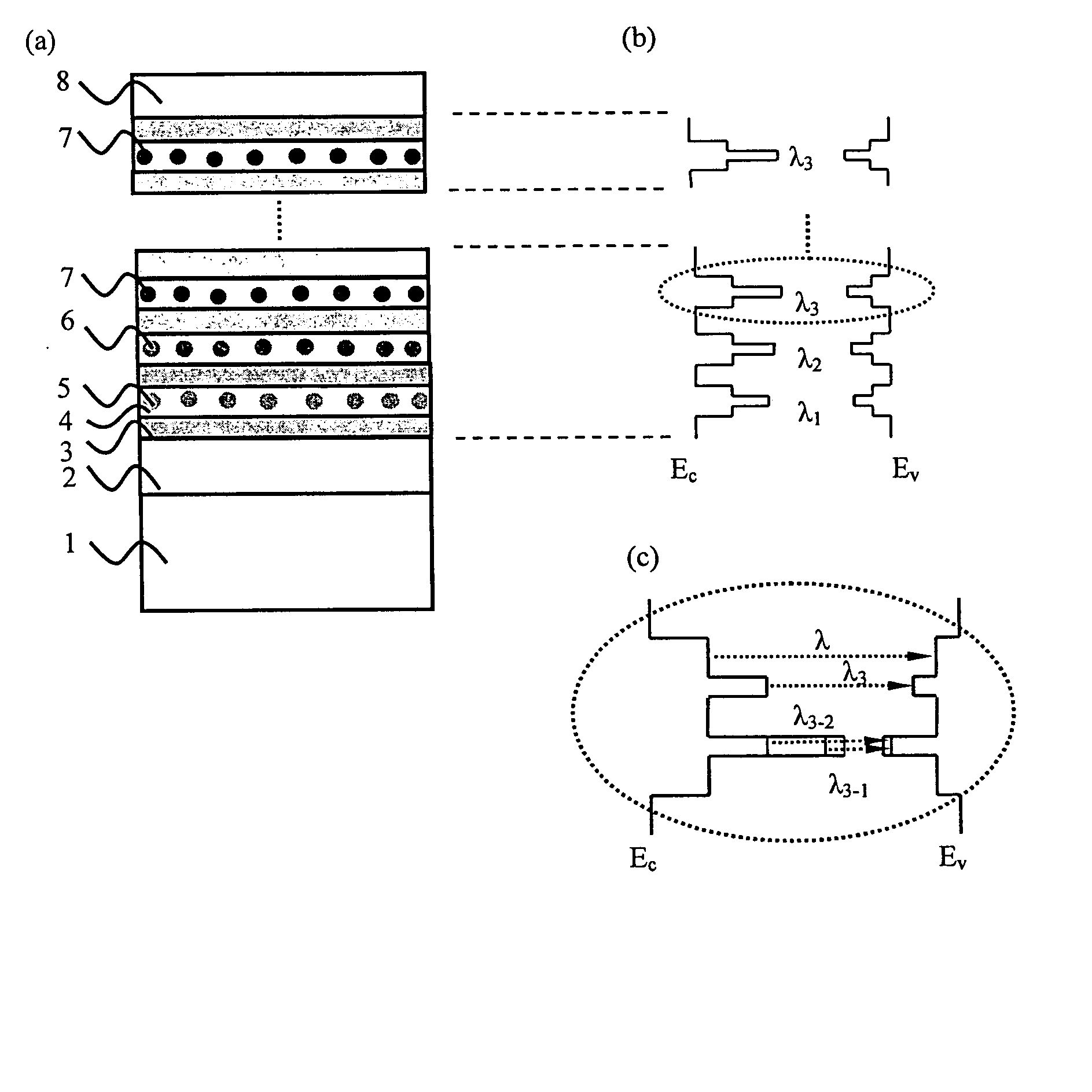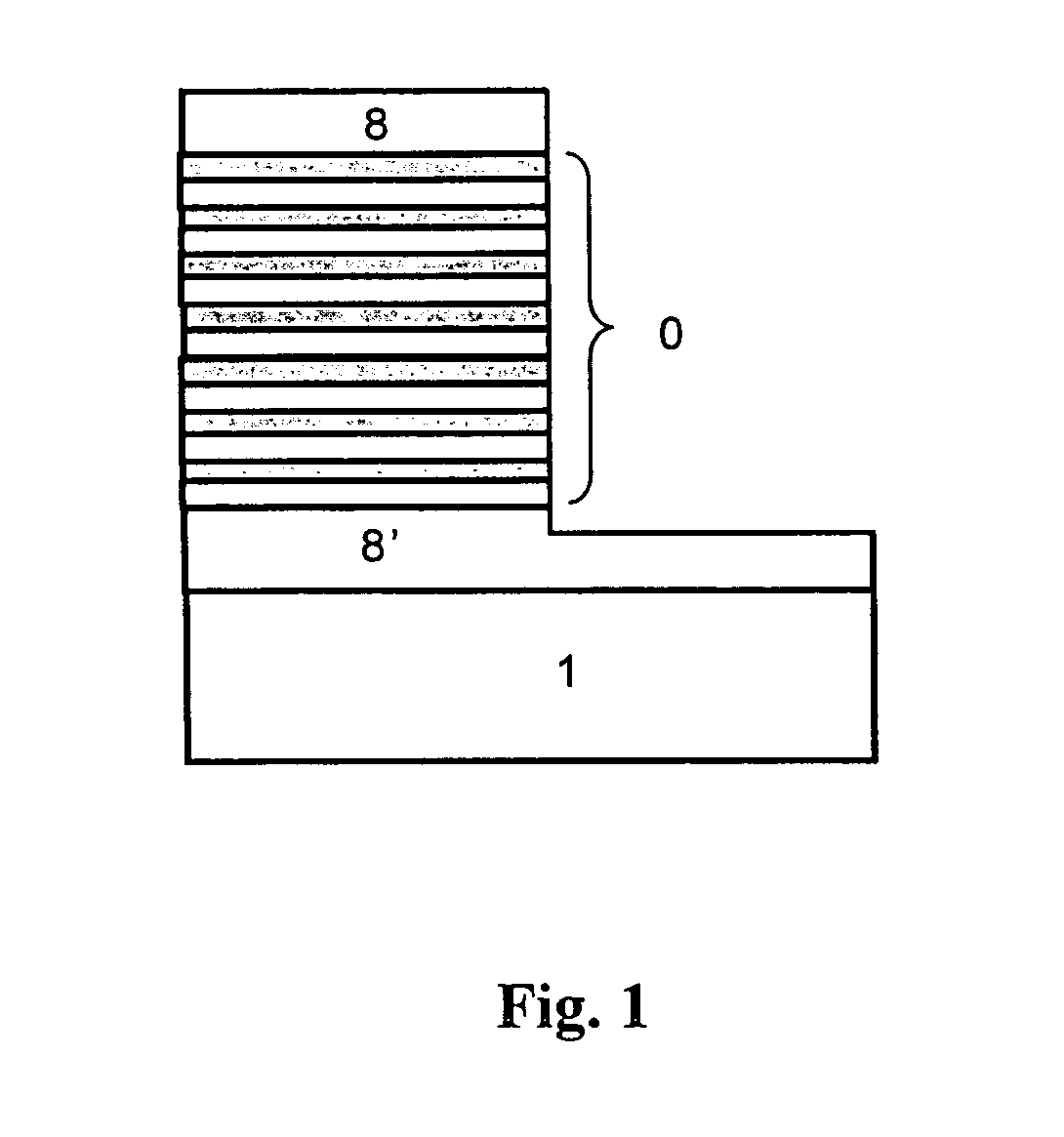Nanoparticle structure and manufacturing process of multi-wavelength light emitting device
a technology of nanoparticles and light emitting devices, applied in the direction of discharge tubes/lamp details, discharge tubes luminescent compositions, discharge tubes/lamp details, etc., can solve the problems of non-applicability of white light generated by complementary dichroism for full color display of objects, problems to be solved, bluish in the center and yellowish in the periphery, etc., to effectively reduce non-radioactive recombination, effectively elevate the light emitting efficiency of led
- Summary
- Abstract
- Description
- Claims
- Application Information
AI Technical Summary
Benefits of technology
Problems solved by technology
Method used
Image
Examples
example 1
Single-Wavelength LED Using Nanoparticle-Containing Active Layer
[0075] As to growth of nanoparticles in MQWs active layer structure effectively, which can reduce non-radioactive recombination rate resulted from dislocation in current MQWs active layers of Group III nitride LEDs, the present invention provides a nanoparticle-containing MQWs structure with single wavelength as active layer, as shown in FIG. 5(a), to elevate emitting efficiency of LEDs. The process comprises steps of, firstly providing a substrate 1 and growing n (or p) type buffer layer 2 on substrate 1, thereafter growing barrier layer 3; then growing lower energy well layer 4 and growing a nanoparticle structure with single wavelength λ1 therein; further growing higher energy barrier layer 3 to complete the single layer quantum well containing nanoparticle structure as active layer. The emitting efficiency of LEDs can be elevated by repeatedly growing the above structure or adjusting growing parameters like tempera...
example 2
Dichroic-Wavelengths LED Using Nanoparticle-Containing Active Layer
[0077] It is known from the above that the emitting wavelengths of the nanoparticles can be obtained by controlling the elemental composition and geometric size thereof. Accordingly, nanoparticles with different elemental composition and geometric size can be grown on different layers inside the MQWs active layer structure, and light emitting diodes with various wavelengths are manufactured. With the emitting properties of the nanoparticle-containing MQWs active layer, it is advantageous to develop white light emitting diodes with practical uses in the lighting applications.
[0078] Therefore, various designs of nanoparticle-containing MQWs structure as active layer are provided in the present invention to hybridize white light. Firstly, a design called “Dichroic wavelengths LED using nanoparticle-containing active layer” is described. Complementary colors generating white light under irradiation of D65 standard ligh...
example 3
RGB LED Using Nanoparticle-Containing Active Layer
[0081] As white light hybridized through combination of the primary colors is of high color rendering, thus is advantageous, nanoparticle-containing MQWs structure with the primary color wavelengths as active layer is provided in the present invention, as shown in FIG. 11(a), to hybridize white light. The related energy bands are shown in FIG. 11(b). First (λ1), second (λ2) and third (λ3) wavelengths denote individual color of the primary colors. Said nanoparticle-containing MQWs structure with the primary color wavelengths as active layer is produced by growing nanoparticles with first emitting wavelength (λ1) in first well layer 4, growing nanoparticles with second emitting wavelength (λ2) in second well layer 4, and growing nanoparticles with third emitting wavelength (λ3) in third well layer 4, then repeatedly growing a plurality of nanoparticle-containing MQWs structures with wavelengths 1, 2 and λ3 in this order to hybridize w...
PUM
 Login to View More
Login to View More Abstract
Description
Claims
Application Information
 Login to View More
Login to View More - R&D
- Intellectual Property
- Life Sciences
- Materials
- Tech Scout
- Unparalleled Data Quality
- Higher Quality Content
- 60% Fewer Hallucinations
Browse by: Latest US Patents, China's latest patents, Technical Efficacy Thesaurus, Application Domain, Technology Topic, Popular Technical Reports.
© 2025 PatSnap. All rights reserved.Legal|Privacy policy|Modern Slavery Act Transparency Statement|Sitemap|About US| Contact US: help@patsnap.com



